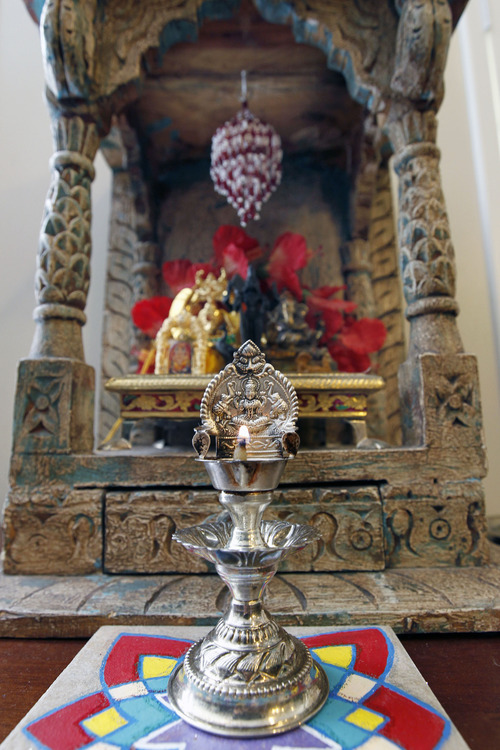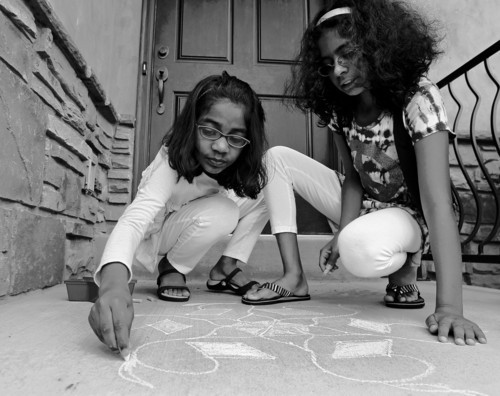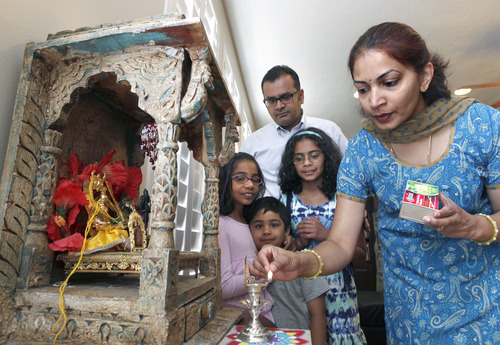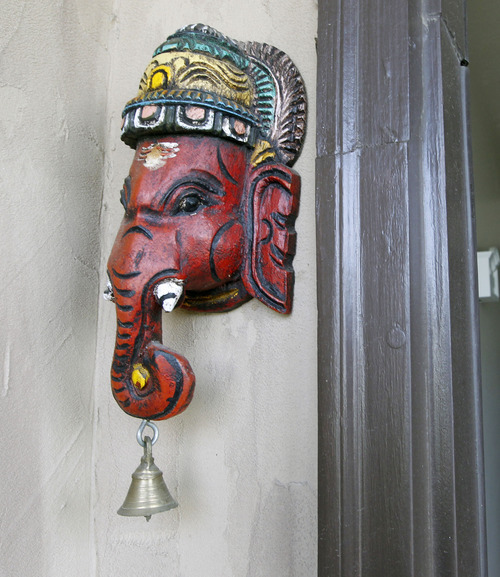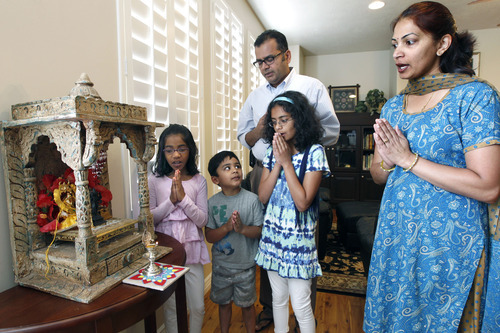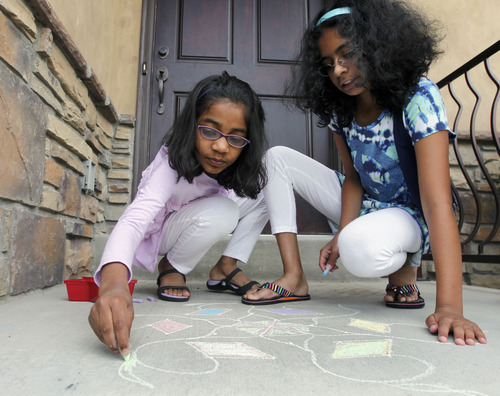This is an archived article that was published on sltrib.com in 2012, and information in the article may be outdated. It is provided only for personal research purposes and may not be reprinted.
Utah's 9,000-strong Hindu community meets often for festivals and celebrations at a Utah temple, but the home is where they conduct most of their worship. A Hindu's day begins and ends with traditional rituals and is punctuated throughout with spiritually tinged practices.
Such daily rituals, at once domestic and divine, are conducted mostly by women.
"Our rituals are essentially prayer and meditation, which are central to Hinduism," says Swathy Mahasenan, a Hindu mom in South Jordan. "The home is intended to be welcoming to the Divinity to enter and bless its occupants. A popular phrase in Hinduism is 'Athithi Devo Bhava,' which literally translates to 'guest is God.' "
About 95 percent of Hindu homes worldwide have a puja – prayer room — or at least a prayer corner, says Satish Kumar, the priest at Utah's Sri Ganesha Hindu Temple in South Jordan.
"God is everywhere and everything is God," Kumar says. "That means he's in your house and in your heart."
Interviews with Kumar, Mahasenan and another Utah Hindu, Indra Neelameggham, offer a brief glimpse of Hindu home rituals and what they mean.
How does a Hindu show his or her faith throughout the day?
Before sunrise, a Hindu woman cleans the front porch, then sprinkles it with fresh water and decorates the door or floor with geometric figures. It is meant to suggest that the home is clean, prosperous and happy.
Neelameggham begins her routine at first light when she opens her eyes, gazes at her palms and repeats a little verse or prayer, she says, "to indicate that fortune and learning are at your fingertips while the Lord is in the middle protecting always."
Typically, the Hindu women will bathe or shower, then light a lamp in front of the home shrine — inviting an "all-pervading enlightenment," she says, to flow "into the home and bless the house."
Each member of the family will pray before the shrine for at least 15 minutes before leaving for school or work.
Are there any special rituals for preparing food, the kitchen and cooking?
Food is generally prepared after the daily bath or shower, then offered to the gods in thanks. The first spoonfuls of rice or sweet dishes are placed on the altar for about 15 minutes as an offering to the gods, while the family says prayers. Such blessed food is then consumed.
"It is the Hindu equivalent of saying grace," Mahasenan says.
Food as an offering to the gods (always vegetarian, made that day and cannot include some ingredients such as onion or garlic) is not tasted or sampled beforehand, she says. The cooking area is cleaned daily, and especially before religious days. Devout Hindus do not eat leftovers. Many Hindus are vegetarian (but dairy is a central part of most diets).
After cooking of the main meal, the women place the first spoonful of rice to birds, Neelameggham says; feeding the birds is said to feed the ancestral spirits who will always guard and protect the home.
What Hindu deities are honored in the home? Are they mostly female ones?
Yes. While Hindus pray to many deities, they tend to have a favored god or goddess to whom they are particularly devoted, Mahasenan says. It might be Lakshmi (goddess of wealth and prosperity), Parvathi (goddess of strength and sustenance) or Saraswathi (goddess of learning and wisdom), who are key female deities worshipped in nearly every Hindu home. As a group, these goddesses represent energy, learning and good fortune.
Prominent male deities are Vishnu (the protector, of whom Lord Krishna and Lord Balaji are among the more famous incarnations), Shiva (the destroyer of evil) and his son Ganesha (the famous elephant-headed god who is the God of beginnings and the remover of obstacles), she says.
Male deities such as Ganesha are often used to decorate the entrance to the home, Neelameggham says. Depending on the family tradition, other gods will find a special place in the home shrine or a picture in the main living space or by the bed. Parents often decorate the bedrooms or cribs of small children and infants with a picture of gods such as Krishna or Murugan who will be their guardian deity.
Do children have unique rituals or do they mostly participate with their parents?
There are no separate rituals performed by children, though many sing simpler hymns, which often serve as their introduction to Hindu mythology, Mahasenan says. Parents transmit their faith through storytelling and repeating mythology. This process of "osmosis" is very important, particularly when cultural icons and practices are not the norm in their new society.
Even a small child will often go and bow before the home shrine without any prompting, Neelameggham says. Children will automatically learn to revere and even adore the icons, shrines and pictures of the many deities. They instinctively fold their palms like their parents in prayer or in greeting of elders and visitors.
As they grow, they learn to recite the prayer songs and start understanding the meaning, she says. Older children soon ask to clean the shrine area, prep it and decorate it with flowers. When allowed to handle a matchbox, they want to light the shrine lamp.
In fact, the first duty of a new daughter-in-law entering the husband's home, Neelameggham says, "is to light the shrine lamp."
Are there specific rituals for pregnancy and childbirth?
There are set prayers and celebrations for the third trimester (especially for the first pregnancy) and another on the 11th day after childbirth. In the third-trimester ceremony, the unborn child is introduced to the scriptures and blessings are invoked for the growing family unit.
A Hindu baby shower (usually during the "resting period") is known as "a bangle ceremony," when friends and family give the expectant mom glass bangles. They are intended to serve "as a deterrent to household chores," Mahasenan says.
Plus, Neelameggham adds, "the jingling noise will keep the evil spirits away."
After a child is born, he or she has a "naming ceremony" on the same occasion as the "11th day ceremony," which marks the purification of the newborn child. Parents note the exact birth time so that an astrological chart — the horoscope — can be written. It will be important later at the time the child weds.
What are the milestones young Hindus celebrate?
The major milestone celebrated after the naming ceremony is the first birthday (considered to mark the time when the child has crossed the period of greatest susceptibility to his/her health), Neelameggham says. Coming-of-age ceremonies vary by gender and sect within Hinduism.
There are many other "little ceremonies" — more like blessing rituals — performed for the first haircut, first feeding of solid food, first time the child is taken out of the home into the sun, first time the child is helped to write and start lessons and so on.
On reaching puberty, girls (particularly in rural areas) have special parties and rituals, while boys have unique rituals to initiate them into religious learning.
The wedding celebration, which can extend over several days, she says, is the most important ritual that makes one say, "I am a Hindu."
Most Hindus also celebrate 60th, 70th and 80th birthdays per religious practice. They believe the 60th birthday, for example, is auspicious — not as the end of active living but a midpoint of a 120-year cycle. It is the end of building a family and career, and the beginning of giving back.
The final rituals are observed after death and cremation and performed by the eldest son.
How do you transmit these Hindu beliefs and practices to your children?
The most important thing is to "walk the talk, so to speak," Mahasenan says. "Children are observant and inquisitive, and a lot of our culture is passed down through conversation."
By making sure to explain the religious purpose of a ritual, it will linger in a child's memory.
As a child, Neelameggham often was told not to leave the dirt pile in the corner after sweeping, lest it "attract the goddess of ill luck or misfortune who will make you miss going to parties."
That was an effective way to get her to do her chores more thoroughly, she says. "It is with such comments and practices that the transfer of tradition takes place in the Hindu home. There is no book to be read or dictum to be followed. You just learn to become a Hindu."
What's up with that red dot on a Hindu woman's forehead?
It is meant as a reminder, asking the gods to give the wearer good thoughts, Kumar says.
But it's not just for Hindu women. Some men wear white dots rather than red, but up to 80 percent of men and women wear them.
It says, "Keep my thoughts in a good way."
Is it tough to practice Hinduism in an American home or culture?
All three observers say no.
"Our friends here are reverent, appreciative and genuinely interested in knowing and understanding about other cultures," Mahasenan says. "We are often engaged in conversations about our religion, but my experience without exception has been that questions were based on genuine curiosity or interest. Some specific aspects of religious practice (such as mopping floors on the day of important prayers) are not compatible with carpeted homes, but the spirit of the occasion can always be maintained."
Overall, she says, "Hinduism is rooted in faith, meditation and prayer, rather than prescriptive practice."
pstack@sltrib.com, Facebook.com/religiongal, Twitter: @religiongal


